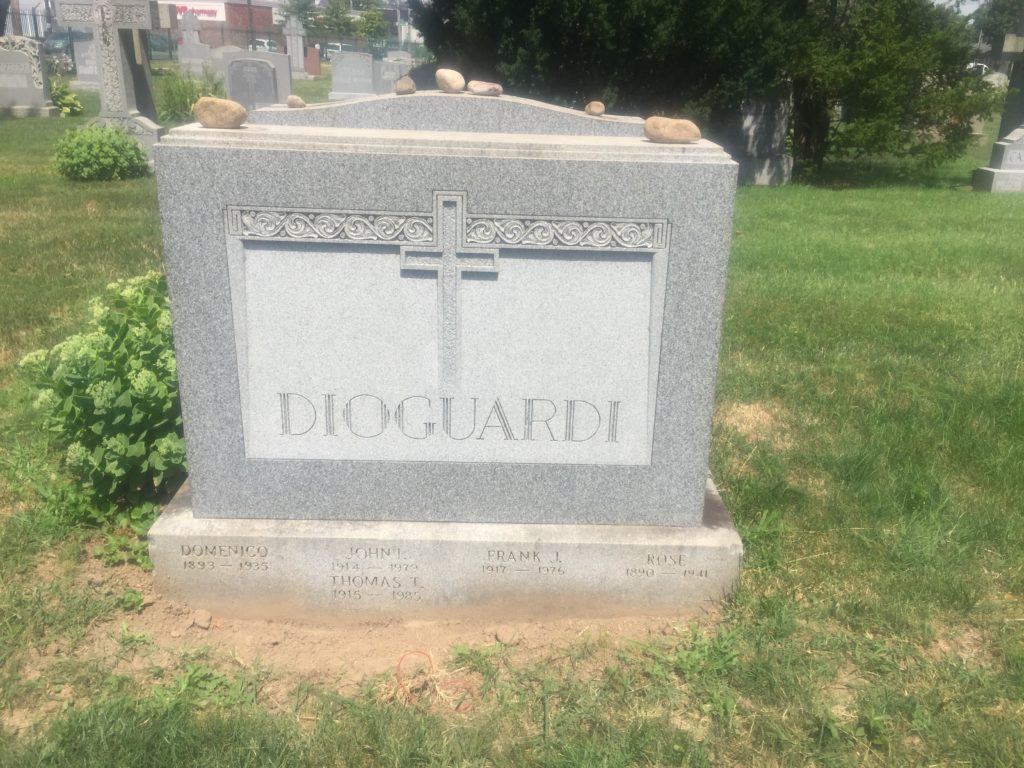Erik Visits an American Grave, Part 1,172
This is the grave of John Dioguardi.

A genuinely horrible human is in this grave. Giovanni Dioguardi, later known as John Dioguardi or Johnny Dio in the underworld, was born in 1914 in Manhattan. By this time, the mafia was already pretty established in the city, having come over with Sicilian immigrants. He grew up with the mob. In fact, mafia figures killed his father in 1930 by shooting him in the head, one of the almost endless mob murders as different gangs battled each other for control of the streets and the riches, or not really that much riches, that came from them.
By the time his dad was offed, Johnny Dio was already in the lower levels of the mob. He and his associates pretty quickly took over a protection racket in the garment district. Recently, historians have contextualized the expansion of the mafia into the New York labor unions and have made a very strong point–the cops didn’t care to do anything about Dioguardi and the like and so what exactly were the union leaders supposed to do? Die? Because that was the choice. The indifference of the cops to what happened in these immigrants opened the world for people such as Dioguardi and they jumped through it with whatever scumbag methods they chose.
It’s not that Dioguardi was ever arrested. He was arrested all the time, but he wasn’t convicted because of the bought off cops and the other fearmongering these murdering bastards could pull off. And while mobsters took over labor, they took over employers associations too. In 1934, Dioguardi was the functional head of something called the Allied Truckmen’s Mutual Association, which meant he was the one negotiating with the Teamsters over their 1934 contract. How do you think that went for the Teamsters? Not well!
Dioguardi finally had to serve three years after a 1937 arrest but upon his release, was back to his old ways. He married, had a couple of sons, and both became mobsters themselves. Nice family. By 1950, he was deeply involved in labor racketeering. Shortly after the creation of the CIO, the United Auto Workers had split. The UAW you know is the UAW-CIO. But there was a UAW-AFL, originally led by the disgruntled former leader of the whole thing Homer Martin. Soon, it became a mobbed up union and Dioguardi was one of its top officers. The point of this “union” was to extort cash from non-union businesses to remain that way and extort cash from unionized places so workers wouldn’t strike. None of this helped the workers, who were irrelevant. Later he was removed from the UAW due to a conviction but then was deeply involved with the Teamsters, whose mafia history is of course quite well known. But Dioguardi was part of Jimmy Hoffa’s coup against the corrupt Teamsters leader Dave Beck in 1955, though so-called “Dio locals” were all disbanded by 1959.
All of this got the attention of the McClellan Committee, which is what put Hoffa in the spotlight of the federal government and which Dioguardi soon was caught up in too, for obvious reasons. He had operated with such impunity for so long that there was tons of evidence against him, such as the former governor of Michigan testifying that Dioguardi had offered him a bribe.
Now, this leads us to one of the myths of American labor history. No one is particularly questioning that the Teamsters were mobbed up. But one of the events that is often used to talk about labor corruption is the acid attack against the anti-union columnist Victor Reisel that left him blind. Reisel was the worst, someone who would slander labor left and right in national columns whether he was right or not. This might be a legitimate discussion of mob ties, it might be calling them all communists. Riesel was indeed blinded and this was Johnny Dio’s deal too. But this did not come out of the labor movement or have anything to do with his attacks on mobbed up locals. Rather, as David Witwer and Catherine Rios explore in their book Murder in the Garment District: The Grip of Organized Crime and the Decline of Labor in the United States, Riesel was blinded because he was deeply invovled in the rackets personally and it was a personal issue between him and Dioguardi that led to the action. It soon became clear to J. Edgar Hoover and the Eisenhower administration was the truth was. But because none of them liked labor and because Riesel played his cards to the end, blaming corrupt unions for it, they kept the truth under wraps. Finally, the government dropped the charges against Dioguardi for it, focusing on the underlings more directly involved. And yet, this myth about labor remains strong to the present among those of a certain generation who remember the incident.
By the late 50s though, the government was cracking down on mobsters more and Dioguardi was in and out of prison for years. The old days of living large were increasingly over. He was in prison more than he was out after 1957, charged with all sorts of things from bribery to extortion to tax evasion to bankruptcy fraud. He died in 1979 in a prison hospital. He was 64 years old. Good riddance.
Oh, and Ronnie James Dio took that part of his name from his favorite mobster.
John Dioguardi is buried in St. John Cemetery, Queens, New York.
If you would like this series to visit other mobster scum, you can donate to cover the required expenses here. Al Capone is in Chicago and Bugsy Siegel is in Los Angeles. Previous posts in this series are archived here.


